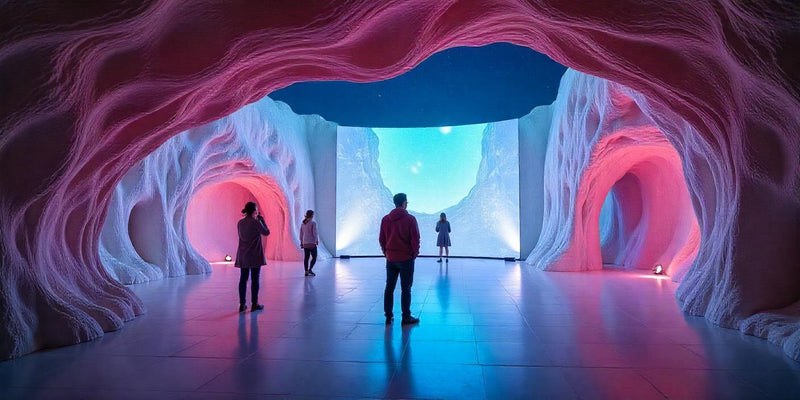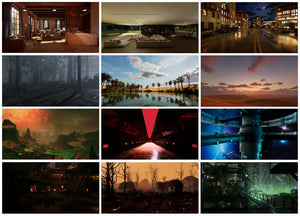Virtual Cave Technology Explained for Beginners

Have you ever wanted to step inside a video game or movie scene? Virtual cave technology makes this science fiction dream a reality. These advanced systems create room-sized digital worlds where users can walk around, interact with objects, and feel completely surrounded by computer-generated environments.
Virtual cave systems represent one of the most exciting developments in modern technology, offering experiences that go far beyond traditional screens or VR headsets. Instead of wearing bulky equipment, users enter specially designed rooms where walls, floors, and ceilings become windows into digital universes.
What is Virtual Cave Technology? Breaking Down the Basics
Virtual cave technology, formally known as Cave Automatic Virtual Environment (CAVE), transforms physical rooms into interactive digital spaces. Think of it as stepping inside a giant computer screen where you become part of the action rather than just watching from the outside.
The concept builds on our natural way of experiencing the world. Rather than limiting your vision to a small screen or headset, CAVE technology basics create 360-degree environments that surround you completely. Multiple high-powered projectors work together to display images on every surface, creating the illusion that you're standing in entirely different locations.
The technology works through sophisticated tracking systems that monitor your position and movements. As you walk around the space, turn your head, or reach for objects, the system adjusts the imagery in real-time to maintain the illusion. This creates natural interactions that feel intuitive and comfortable.
Modern virtual cave installations can simulate anything from ancient historical sites to futuristic cities, from microscopic cellular structures to vast cosmic landscapes. The only limitation is the imagination of the content creators and the processing power of the computer systems.

The Science Behind Immersive Environments: How Virtual Caves Work
Immersive environments rely on several key technologies working in perfect harmony. The foundation starts with multiple projection systems positioned around the room. These aren't ordinary projectors – they're specialized units capable of displaying ultra-high-resolution images with precise color accuracy and brightness.
The projection mapping process ensures that images align perfectly across different surfaces. Complex algorithms calculate how images should appear on walls, floors, and ceilings so that the overall scene looks seamless from the user's perspective. This mathematical precision prevents the jarring visual breaks that would destroy the illusion.
Motion tracking represents another critical component of immersive environments. Sensors placed throughout the room monitor the position of users' heads, hands, and bodies. Some systems use infrared cameras, while others employ electromagnetic sensors or optical tracking methods. The choice depends on the required precision and the specific applications.
Computer systems process this tracking data instantly, recalculating how the virtual world should appear from each user's unique viewpoint. This happens dozens of times per second, ensuring that movements feel natural and responsive. The computing power required for this real-time processing has only recently become affordable and accessible.
Audio systems complete the immersive environments experience. Carefully positioned speakers create three-dimensional soundscapes that match the visual content. Users hear sounds coming from specific directions and distances, just as they would in the real world.
Virtual Reality Cave vs Traditional VR: Understanding the Differences
Virtual reality cave systems offer distinct advantages over traditional VR headsets. The most obvious difference is freedom of movement. While headset-based VR often restricts users to small play areas, cave systems allow natural walking and interaction within room-sized spaces.
Comfort represents another significant advantage. VR headsets can cause fatigue, motion sickness, and discomfort during extended use. Virtual reality cave environments eliminate these issues because users see the virtual world with their natural vision rather than through screens inches from their eyes.
Social interaction flourishes in cave environments. Multiple people can share the same virtual space simultaneously, seeing and interacting with each other naturally. Traditional VR typically isolates users in individual experiences, making collaboration and shared activities more challenging.
The visual quality in virtual reality cave systems often surpasses what's possible with current headset technology. Large projection surfaces can display images at resolutions and scales impossible to achieve with small screens. Fine details become clearly visible, and the sense of scale feels more authentic.
However, traditional VR headsets offer their own advantages, particularly in cost and flexibility. A complete cave installation requires significant space, specialized construction, and substantial investment. VR headsets provide immersive experiences in any location at a fraction of the cost.
CAVE System Overview: Components and Architecture
A comprehensive CAVE system overview reveals the sophisticated technology required to create convincing virtual environments. The physical structure typically consists of a cube-shaped room with projection surfaces on three or more walls, plus the floor and sometimes the ceiling.
Projection systems form the visual foundation. High-end installations use multiple projectors per surface to achieve the brightness and resolution needed for convincing imagery. These projectors must be precisely calibrated to ensure color accuracy and seamless image blending where projections overlap.
Computer clusters power the graphics processing. Creating real-time imagery for multiple high-resolution surfaces requires substantial computing power. Modern CAVE system overview implementations often use multiple connected computers, each responsible for rendering specific portions of the virtual environment.
Tracking systems monitor user positions and movements. The most advanced setups can track multiple users simultaneously, each with their own perspective on the virtual world. This capability enables collaborative applications where teams can work together within the same virtual space.
Control systems manage the entire experience. Software coordinates the projectors, computers, tracking systems, and audio equipment to create seamless virtual environments. Users typically interact through gesture recognition, voice commands, or specialized input devices designed for the virtual space.

Applications: Where Virtual Cave Technology Shines
Virtual cave technology finds applications across numerous industries and fields. Medical training programs use these systems to let students practice procedures in risk-free virtual environments. Surgeons can rehearse complex operations, while medical students can explore detailed anatomical models from every angle.
Architecture and construction benefit significantly from immersive environments. Architects can walk clients through buildings before construction begins, making design changes when they're still affordable to implement. Construction teams can identify potential problems and optimize workflows before breaking ground.
Scientific research utilizes virtual reality cave systems to visualize complex data sets. Researchers can walk through molecular structures, explore astronomical phenomena, or examine geological formations in ways impossible with traditional displays.
Entertainment and gaming represent growing applications for CAVE technology basics. Theme parks and entertainment venues create immersive experiences that transport visitors to fantastic worlds. Gaming applications allow players to become fully immersed in virtual adventures.
Education transforms when students can step inside historical events, walk among dinosaurs, or explore distant planets. Virtual cave technology makes abstract concepts tangible and creates memorable learning experiences that traditional teaching methods cannot match.
Getting Started: Your First Steps into Virtual Cave Technology
Beginning your journey with virtual cave technology requires understanding both the possibilities and the practical requirements. Start by identifying specific applications that would benefit your organization or interests. Different use cases require different levels of complexity and investment.
Budget considerations play a crucial role in planning. Basic CAVE system overview setups might cost tens of thousands of dollars, while high-end installations can require hundreds of thousands or more. Factor in ongoing costs for maintenance, software licensing, and content development.
Space requirements must be carefully evaluated. Most immersive environments need dedicated rooms with controlled lighting and acoustics. The physical space must accommodate both the projection equipment and user movement areas.
Content development represents another important consideration. Creating compelling virtual environments requires specialized skills and software. Some organizations develop content internally, while others work with specialized vendors or use existing content libraries.
Technical support and training ensure successful implementation. Virtual reality cave systems are complex, requiring knowledgeable operators and regular maintenance. Plan for staff training and ongoing technical support from vendors or consultants.

The Future of Virtual Cave Technology
The future holds exciting possibilities for virtual cave technology. Advances in display technology promise even higher resolutions, better color accuracy, and more flexible installation options. New projection methods may eliminate the need for traditional projectors entirely.
Artificial intelligence will enhance immersive environments by creating more responsive and intelligent virtual worlds. AI-powered characters and environments will adapt to user behavior, creating personalized experiences that evolve over time.
Haptic feedback technology will add the sense of touch to virtual reality cave experiences. Users will feel virtual objects, textures, and environmental effects, making the digital world even more convincing and interactive.
Network connectivity improvements will enable shared virtual spaces across global distances. Teams separated by continents will collaborate in the same virtual environment as if they were in the same physical room.
Cost reductions and simplified installation procedures will make CAVE technology basics accessible to smaller organizations and educational institutions. Standardized components and streamlined setup processes will democratize access to these powerful tools.
Conclusion
Virtual cave technology represents a significant leap forward in how we interact with digital content. By creating room-sized immersive environments, these systems offer natural, comfortable ways to experience virtual worlds that surpass traditional display methods.
The applications span from education and training to entertainment and research, with new possibilities emerging as the technology continues to advance. While current systems require substantial investment and technical expertise, ongoing developments promise to make virtual reality cave technology more accessible and powerful.
For organizations considering implementation, careful planning around budget, space, content, and support requirements will ensure successful deployment. The investment in CAVE technology basics can transform how teams collaborate, learn, and create in ways that traditional technology cannot match.
As we look toward the future, virtual cave technology will likely become an increasingly important tool for education, research, design, and entertainment. The ability to step inside digital worlds and interact naturally with virtual content opens possibilities we're only beginning to understand.
Frequently Asked Questions
Q: What is the difference between a virtual cave and VR headsets?
A: Virtual cave systems create room-sized immersive environments where multiple people can participate without wearing headsets. VR headsets provide individual experiences but can cause discomfort during extended use and limit social interaction.
Q: How much space do I need for a virtual cave system?
A: Most CAVE system overview installations require dedicated rooms ranging from 10x10 feet for basic setups to much larger spaces for advanced systems. The exact requirements depend on the intended applications and number of simultaneous users.
Q: What are the main costs involved in virtual cave technology?
A: Costs include hardware (projectors, computers, tracking systems), software licensing, room construction or modification, installation, training, and ongoing maintenance. Basic systems start around $50,000, while advanced installations can cost several hundred thousand dollars.
Q: Can virtual cave systems track multiple users simultaneously?
A: Yes, advanced immersive environments can track multiple users, allowing collaborative experiences where teams work together in the same virtual space while each person sees the environment from their own perspective.
Q: What industries benefit most from virtual cave technology?
A: Key industries include education, medical training, architecture, engineering, scientific research, entertainment, and manufacturing. Any field requiring 3D visualization, training simulations, or collaborative design work can benefit from virtual reality cave systems.
Q: Do I need special training to operate a virtual cave system?
A: Yes, operating CAVE technology basics systems requires training on the hardware, software, and safety procedures. Most vendors provide initial training and ongoing support to ensure successful implementation and operation.
Q: How realistic are virtual cave environments?
A: Modern virtual cave systems can create highly realistic environments with proper content development. The level of realism depends on the quality of the graphics, the resolution of the projection systems, and the sophistication of the tracking and audio systems.
Q: Can virtual cave technology be used for entertainment?
A: Absolutely. Immersive environments are increasingly used in theme parks, gaming centers, and entertainment venues to create unique experiences that transport visitors to fantastic virtual worlds.




